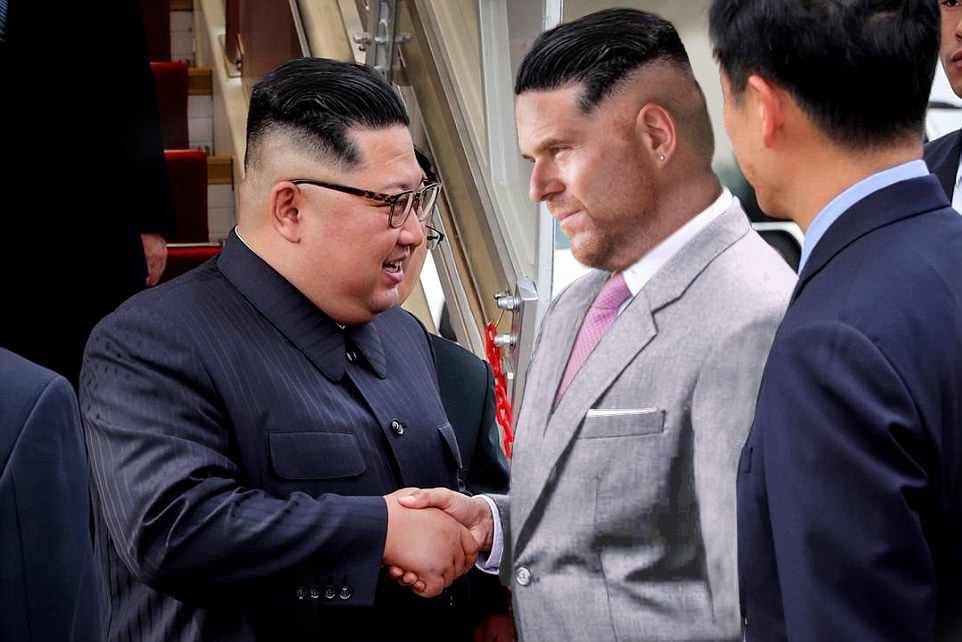Switzerland is the land of three-cheek kisses (along with Slovenia, Serbia, Macedonia, Montenegro, the Netherlands, and Egypt), seven presidents (a collective of co-equally powered heads of state known as the Federal Council), and about a million banks—all of this to serve a population of 8.5 million, the same as New York City. They also happen to host a particularly exceptional art fair in Basel, with attendance clocking in around 100,000 over the course of six days. I’d like to say that’s the end of the numbers-bandying in this column, but it’s only the beginning, I’m afraid—which is rich coming from someone who still counts on their fingers.
An Art-Market Aside…
The United Talent Agency and collector/trader Peter Brant are launching the UTA Brant Fine Art Fund, seeking to raise $250 million to speculate on “best-in-class” works by blue-chip postwar (i.e. 1945-70) and contemporary (i.e. 1970-present) artists, with an investment lock-up of seven years or more. UTA has operated an uneventful downtown LA art gallery for the past few seasons, recently relocating it to Beverly Hills, and Brant has played at the art market (spectacularly) for 40 years. I can imagine the Hollywood pitch: The Terminator joins Goldman Sachs to go on a shopping spree, with VIP front-row access (to fairs and auctions) for all involved.
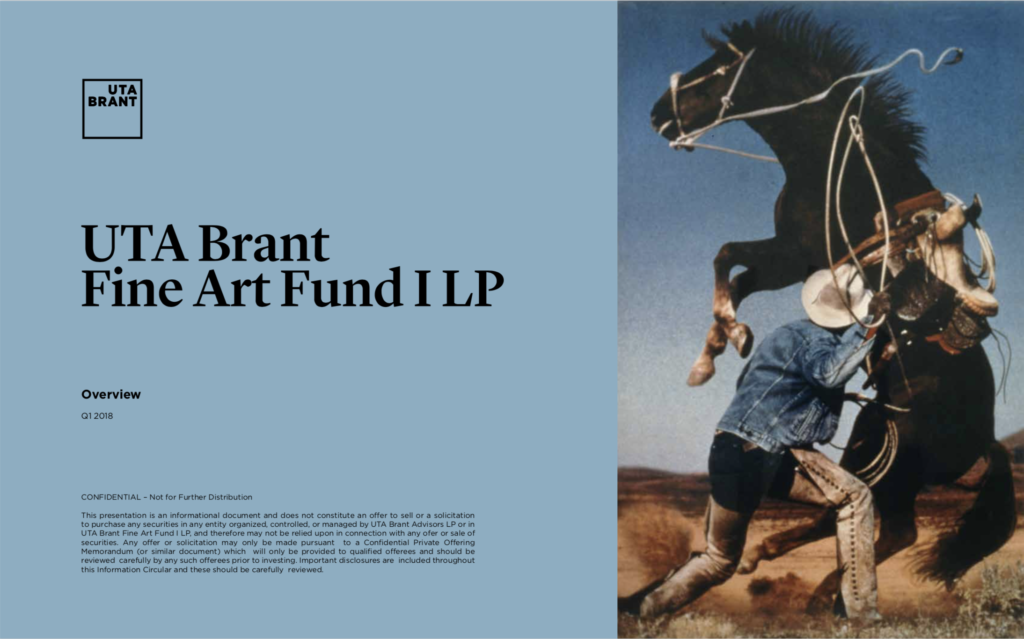
Jacking Richard Prince images is becoming an international pastime. Everyone is doing it—in this case for crass commercialism beyond the bounds of the (already crass) art market. Image courtesy of Kenny Schachter.
I know one person who is going to be plenty pissed off, for starters: Richard Prince, who recently lamented Aby Rosen’s copying of his works for the developer’s latest restaurant, the Lobster Club (who names these places?), and also Per Skarstedt’s upcoming show of early joke paintings in London, undertaken without his consultation. (Despite the artist’s Insta-protest, Prince ended up loaning a piece for the exhibition.) Now the UTA/Brant prospectus prominently features a major Prince cowboy photo (surely without his consent), which is certain to raise the hackles of the prickly artist—though, for someone who single-handedly snuffed out copyright protections, he’ll have a tough time gaining sympathy. As the artist (a hero of mine) said himself, “I’m not interested in that little ‘c’ in a circle.”
Speaking of disclaimers, the page of the UTA Brant fund’s prospectus entitled “Risk Factors” includes the fact that the fund is based on one key 71-year-old personnel member who is replete with “conflicts of interest” (that is their language), adding that “[t]he Fund is not subject to the same regulatory requirements as mutual funds” and that “[t]he advisory compensation due to the Investment Manager may be substantial regardless of whether the Fund has a positive return.” In other words, there are acknowledged conflicts when the fund buys and sells, but no conflict when it comes to compensating the manager—i.e., he gets a lot regardless of how much you get in return (if anything). Nice job if you can get it.
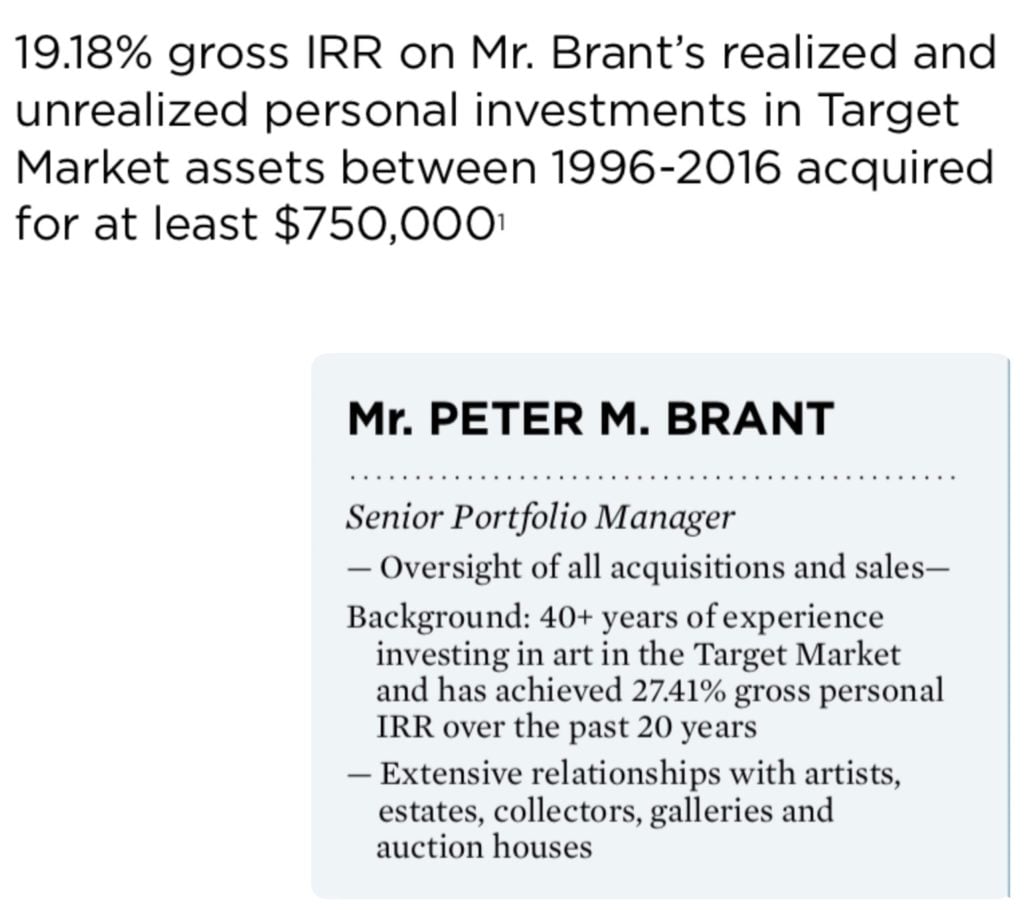
I was never very good at math but these guys are worse than my kids. Screenshot courtesy of Kenny Schachter.
Back to the numbers, some doozies were disclosed: Brant, who is unequivocally among the world’s most knowledgeable participants in the art market with an enviable, legendary personal hoard, is said to have achieved a 19.18 percent rate of return from his personal art investing from 1996 to 2016, which for some unknown reason grows to 27.41 percent for the same period by the last page of the offering. This is plain sloppy. It also states that Brant guaranteed a total of $100 million of art from 2013 to 2016, with a profit of $6.2 million on the bets. Hmm, thanks for sharing.
Basel Nights
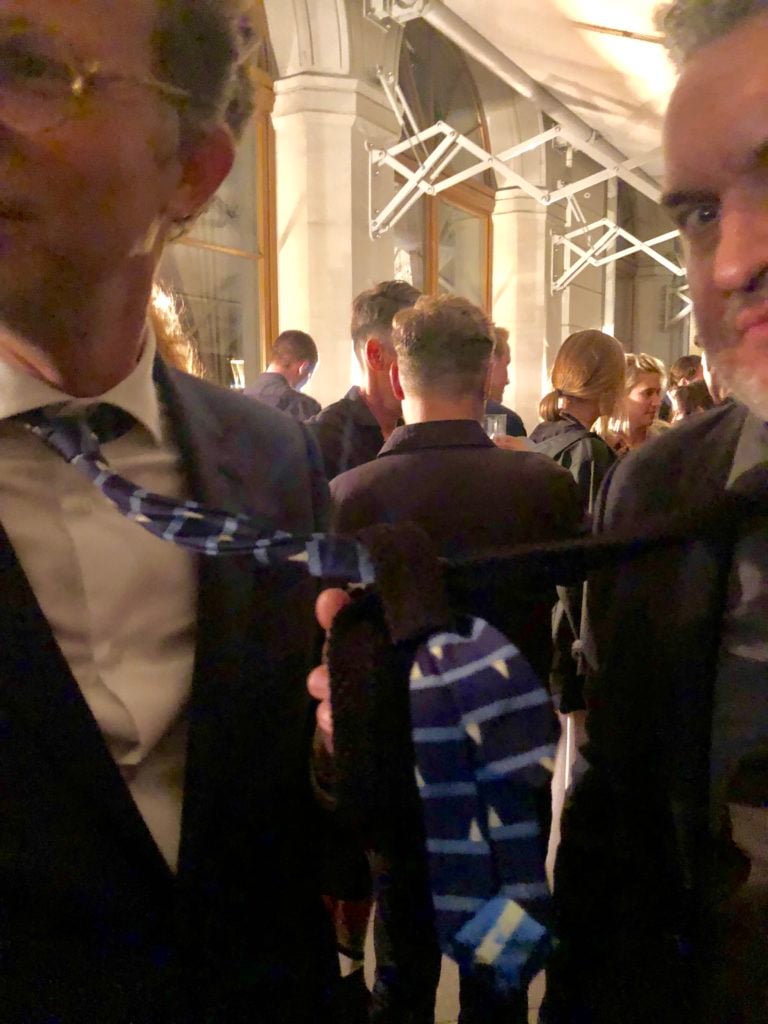
What drunk people get up to at 3 am. Sotheby’s Martin Klosterfelde and Mills Moran of Morán Morán Gallery in LA. Photo by Kenny Schachter.
Baseling is a verb that entails looking at a lot of art and drinking nearly as much. Somehow, the most exclusive hotel in town, Grand Hotel Les Trois Rois (aka the Three Kings), transforms into a raucous free-for-all every night of the fair, full of the rich, the poor, and the in-between—a democratic (albeit skewed to the high-end) mosh pit of art warriors that is a thing to behold. If you can recall anything, that is. There are the biggest and smallest gallerists, collectors, artists, auctioneers, and other art-worker bees (plus plenty of hangers-on) commingling, fueled by institutional amounts of alcohol laboriously acquired from a bar staff that seems to work just one week per year. Underlying the veneer of congeniality is a level of aggression that would give pause to Bruce Nauman (whose “Disappearing Acts” retrospective at the Schaulager was a highpoint of this year’s Art Basel). Like when Gavin Brown threatened to throw me into the Rhine.
A noted collector was on all fours in the lobby looking for his front tooth, while Robert Longo was trying to (re)locate his phone that had gone missing for the third time that day. I’ve misplaced more in Basel’s past, trust me (my soul?). I was lucky enough to get a Three Kings room at the last minute, but had to speak in codes on the balcony so that my immediately contiguous neighbor wouldn’t cotton onto my deal flow. You can’t fart in peace in a city as tiny as Basel. The good news? I managed to sell my original, less glamorous hotel reservation through the fair’s VIP department. I should buy a block of rooms next year and arbitrage them into a secondary market.
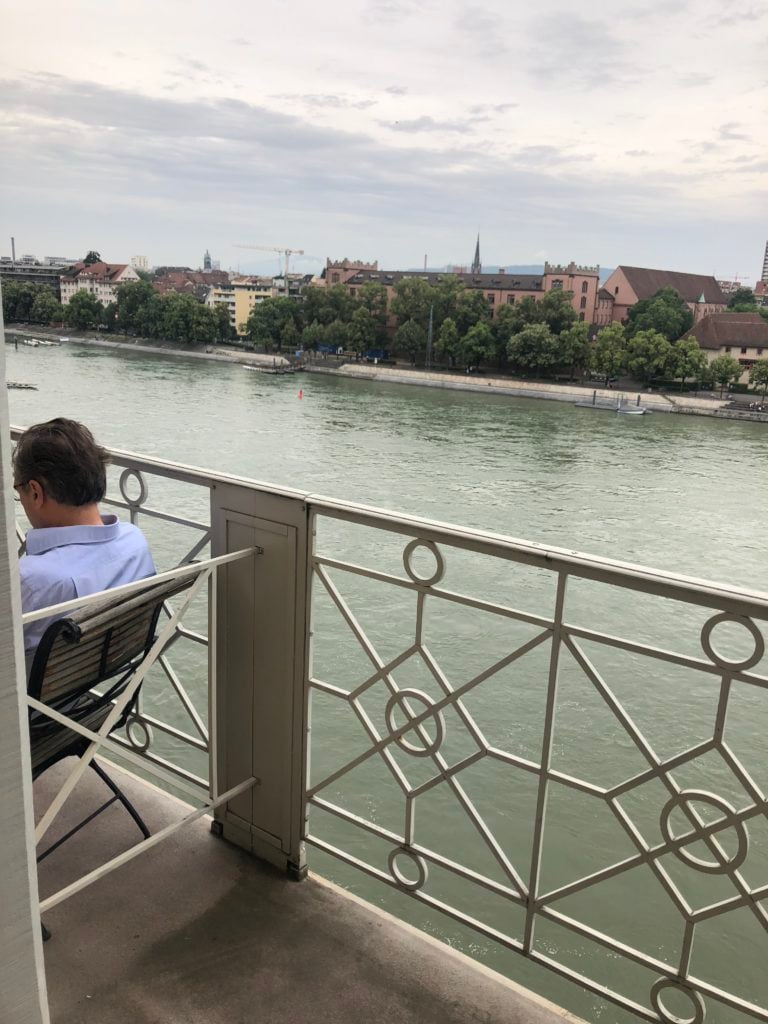
I actually used a code name to describe one deal participant on my Three Kings balcony because my neighbor was so close I could pull his hair. Photo courtesy of Kenny Schachter.
A friend gave me an e-cig containing THC (the psychoactive ingredient of marijuana), which I thought couldn’t hurt until I was chatting to a collector and smelled a pungent mixture of burning weed and flesh. This turned out to be my ass, as the pipe in my pocket got stuck in the “on” position when I sat down. Ouch. I hear Gagosian made an investment in the burgeoning sector.
In the land of full disclosure we willfully inhabit on the net, everyone has their pants down—it’s more a matter of a right to publicity than privacy. We show and tell all on our own volition, and because discretion is passé no one appears to want it anymore. Especially when they are shit-face drunk. Like when Joe Nahmad of Nahmad Contemporary in New York let slip that the family had sold two paintings by the same artist for a total of $300 million a few months ago. Afterwards, I spent a considerable amount of time chasing him around the bar trying to extract who, exactly, that artist might be.
Joe responded I was taking advantage of the situation, but I am a reporter in the trenches, and I’ve learned to stay three drinks less inebriated than the rest (although that is admittedly fairly wasted). All I managed to elicit was that it’s an artist born between 1900 and 1915, who I’d bet is Rothko—which Joe denied when I followed up the following day, but in the same half-hearted way his brother denied the recent Rockefeller Picasso guarantee I disclosed in my last piece (i.e. not very resolutely). Marc Glimcher divulged in no uncertain terms that his personal best was $165 million, also for a Rothko. Myself, I’m an amateur at $35 million for a Cézanne. I know this sounds casually privileged, but there’s nothing cavalier about it. It’s hard graft.
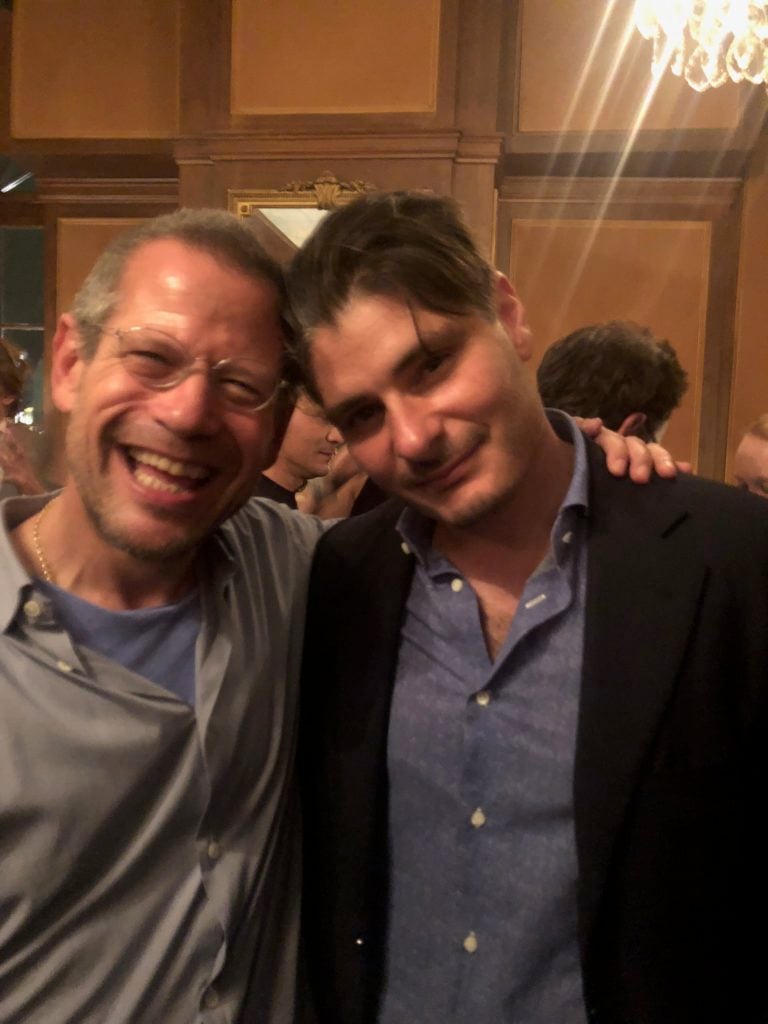
Me and Helly Nahmad. (Yes I know, I’ve seen better times, indeed…) Photo courtesy of Kenny Schachter.
As much as l respect Peter Brant’s art acumen, I have the utmost admiration for the Nahmad clan, Three Kings stalwarts who went from owning a Syrian bank selling art in financial downturns to a bank of art for every occasion. In the 1970s and ’80s, the family accounted for as much as 80 percent of both the buy and sell sides of the Modern and Impressionist auction markets, during recessionary times when demand didn’t contract but rather evaporated. The Mugrabis fill the same role on the contemporary side, and the families have seemingly joined forces for some deals, lording over the art market like The Godfather squared—with consigliere Larry G. never far behind. I’m not being disingenuous when I say l love them: They make a leap of faith (and capital) for art that few, if any, have ever done at that scale before them. And they’ve done it for decades.
The artist collective Lloyd Corporation has made a video about a dubious cryptocurrency—I thought they all were?—called OneCoin, a Ponzi scheme where aspiring entrepreneurs were separated from their funds instead of augmenting them. (Sounds like the basis for an art fund.) A line in the video is: “How much do you earn a year, and how much do you want to make?” Asking someone that question is more taboo than… anything! It makes inappropriate sexual questions seem like a walk in the park.
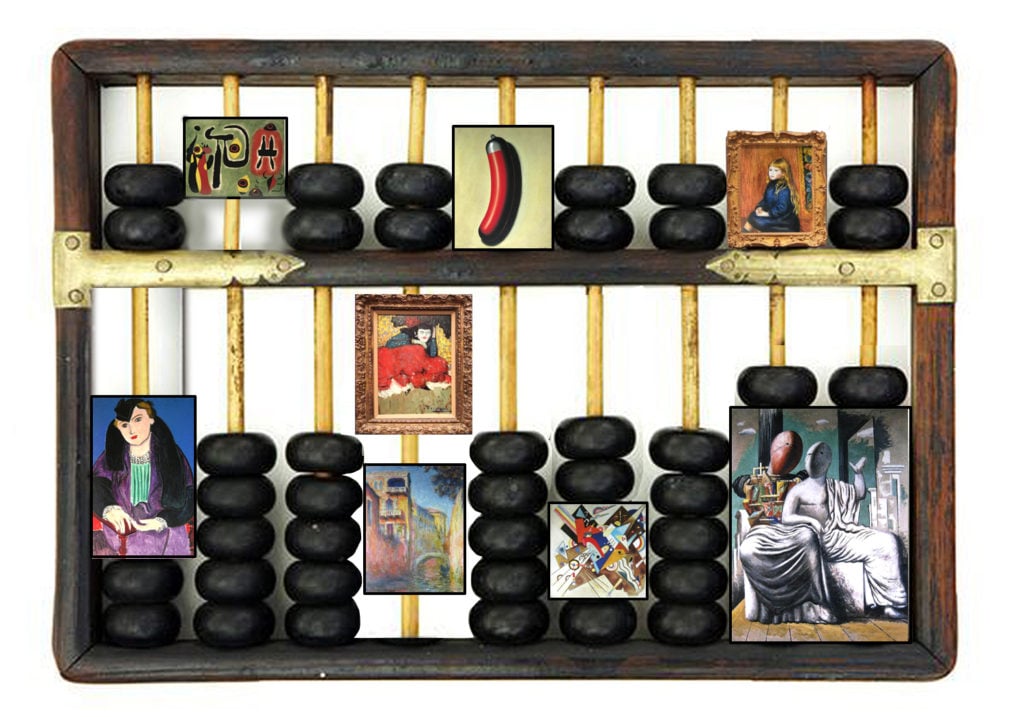
How much do you earn? A few pictures are worth a billion words, or dollars. Photo illustration by Kenny Schachter.
One night Nahmad père was randomly asked such a question by way of a small-time New York spec-u-lector, and to my astonishment he actually replied that the family owned $1.5 billion of Picassos and another $8.5 billion in sundry other artists. (Forbes, meanwhile, pegs their wealth at $1.8 billion.) Now I just need to find out how many Warhols the Mugrabis have and my life will be complete. These people tally their wealth not by bank balances but by an art abacus.
Art Basel
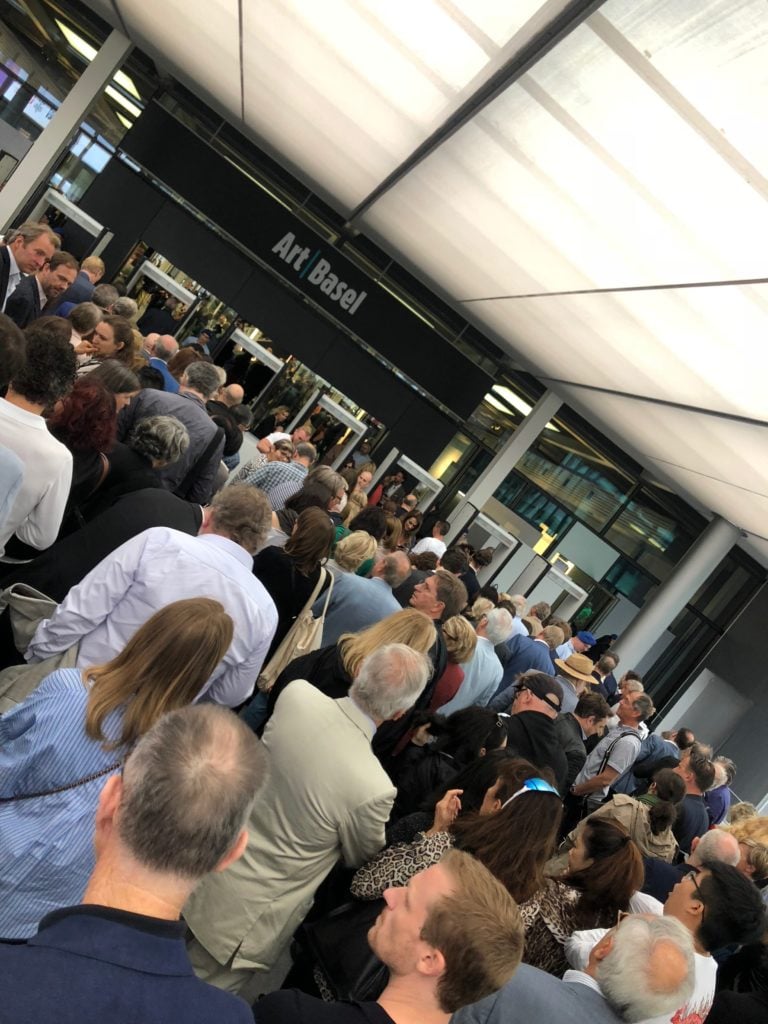
The only thing more dangerous than impatient rich people is living in London, where for the first time there have been more murders than New York. Photo by Kenny Schachter.
The rhetoric swirling around fairs today that larger, more successful galleries should subsidize smaller spaces smacks of the New Deal’s Works Progress Administration (WPA) under Franklin D. Roosevelt, which introduced programs to support the unemployed, the youth, and the elderly in order to revive the economy. I don’t believe there’s a place for art-fair activism in what is, after all, just a business (often resembling monkey business). Josh Baer floated the idea that gallery dinners should be forsaken the first night before the fair kicks off and the money contributed to charity, but this is absurd. People are charitable according to their own devices—you can’t decree it. Imagine going to Goldman and telling them it’s Give-Away-a-Derivative-Day.
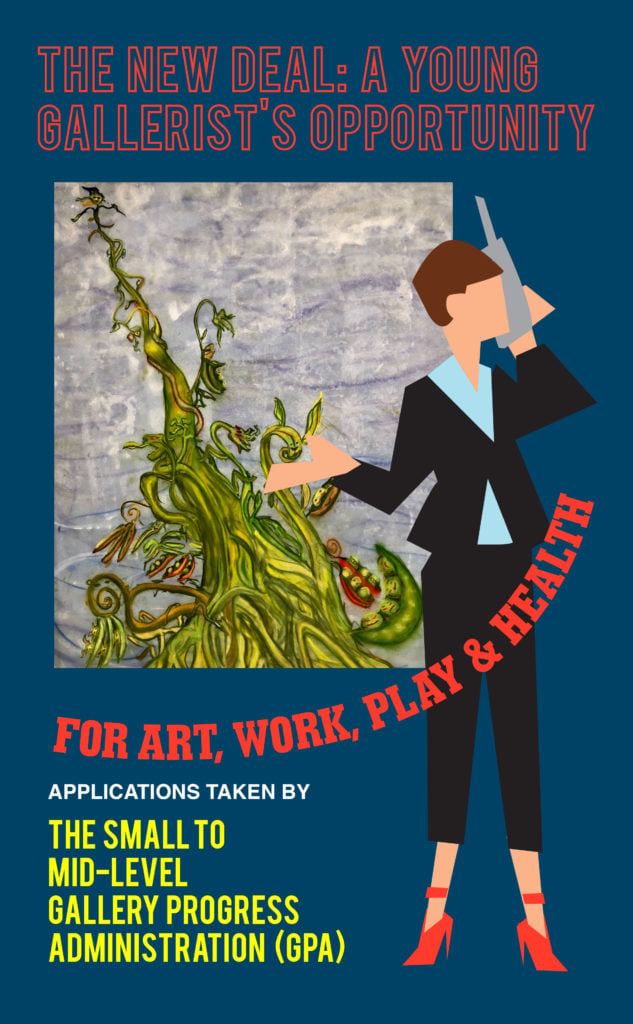
Alms for the small-to-mid-level galleries. Illustration courtesy of Kenny Schachter.
I received an anonymous guerrilla email, literally (the address was [email protected]), stating that Gagosian was handed an entirely free booth by Frieze in exchange for merely showing up. [A spokesman for Frieze, Michelangelo Bendandi, says the notion that the fair gave Gagosian a free booth is “completely untrue.”] I was told not to respond to the missive and, like a scene from Mission Impossible, that the account would shortly disappear. I find this more on the order of sound business practices than scandalous, since if you’ve ever set foot in a Larry G. booth you know you encounter a whirlwind of otherworldly energy inimitable by any other single gallery at any fair. The gallery had their best-ever Basel this year, according to an insider.
A legit complaint I heard from a handful of mid-sized dealers was that when the artists they nurtured get picked up by bigger galleries, the more powerful dealers in return squeeze out the little guys and gals from their perches on the selection committees. The square in front of the fair was peopled with Basel hospitality helpers holding up signs that read “Ask me,” a sign of the ever-corporatizing art world. I asked one if I should buy a Christopher Wool.
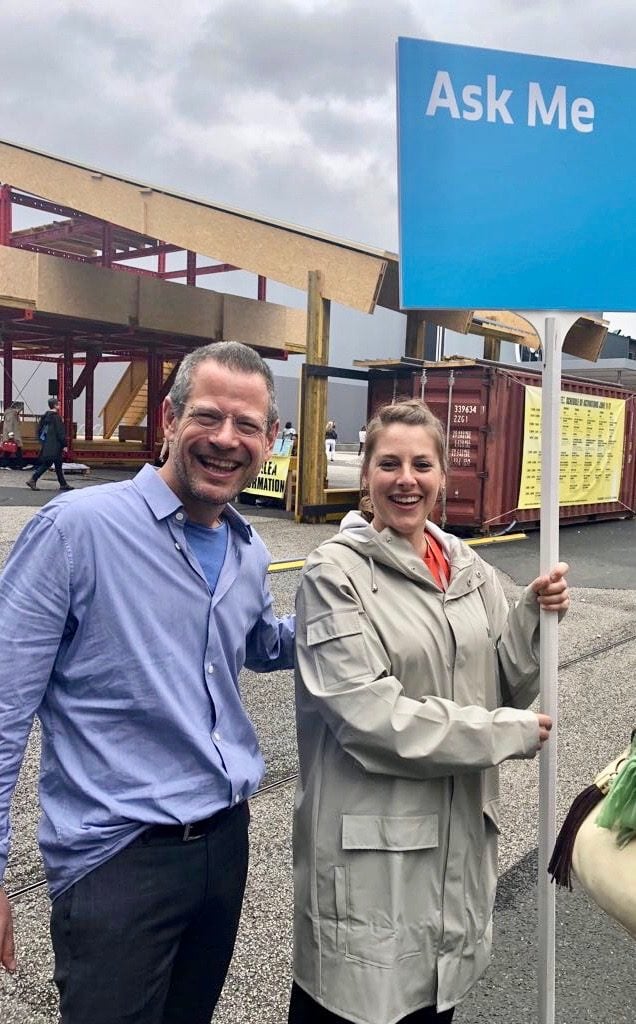
Okay, if you say so, here goes: should I buy a Christopher Wool? Photo courtesy of Kenny Schachter.
Just getting in during the onset of the opening is like wading through a battlefield of impertinence. And when you do finally get in, it’s physically grueling; I should design a portable seat that doubles as a potty so as not to waste time searching for the impossible-to-find toilets. When you are in art mode, there is a veritable news blackout—it’s hard to allow for anything else to enter your consciousness, including Kim Jong-un’s rendezvous with Trump. Unless Jong-un bought a Stingel, I wouldn’t notice. Another fair hazard—you can overdose on sorbitol from breath mints (even if I wish more would use them), which can cause gastrointestinal distress, just so you know.
Pre-selling at fairs is the equivalent of auction guarantees, creating a bit of theater that allows dealers to flex (as my kids say) to their peers. Art is the only commodity that has as many different prices as there are people who ask; a half dozen times I was quoted varying figures by different staff members of the same galleries, with the disparity between the high and low totaling $500,000. Everyone has heard of a couple that marries, divorces, and marries again, and the art world is no different—like when the Mugrabis sold a Basquiat to the Fertitta brothers for around $6 million or $7 million a few short years ago, only to find themselves negotiating for it back via Lévy Gorvy, but now for $17.5 million.
I went to a Simon Lee Gallery dinner and the talk turned to Frize (that’s not a typo). Bernard, that is, the 64-year-old French painter shared with Perrotin. Seventeen paintings had sold on opening day for prices up to €85,000, and I put one on hold after a few bottles only to find that actually 18 were shifted after you factor in the fact that they flogged the painting I had reserved out from under me. That does nothing to diminish how much I adore Simon and his partner in life and gallery, Carine Szwajcer, daughter of longtime Antwerp gallerist Micheline—it’s just art-dealing.
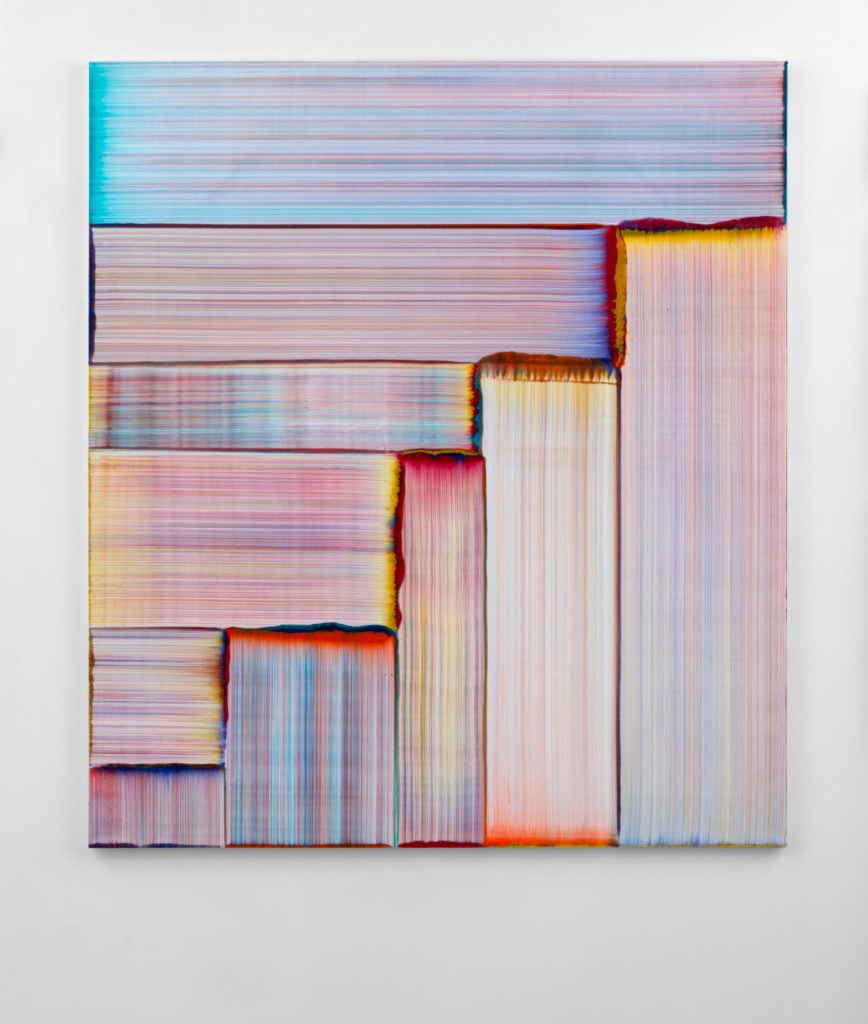
Going, going, gone—but to another collector. This Bernard Frize painting was sold (out from under me) at my friend Simon Lee’s gallery. Photo by Kenny Schachter.
A few (rare) benevolent fair moves of note include a dispensation that allowed Viennese dealer Georg Kargl’s widow, who took over the running of his gallery after his death in May, a berth at the fair to continue the mission, as well as a space for John Armleder’s Ecart Gallery from Geneva, which hasn’t existed since the mid-1970s when Armleder first began exhibiting works by emerging artists in a micro-corner—the word booth would be too generous a term to describe the tiny stand.
By day two, Sadie Coles—when does she not sell out her booth?—was clad in a khaki green jumpsuit distinctly resembling military fatigues, giving further evidence of the combat that art dealing (and partying) has become. I should crawl along the fair floor, serpentining my way commando-style to keep a low profile (also known as hiding). Mills Moran of Morán Morán (don’t ask) said if I threw up watching the lone VR work in the entire fair, by Jacolby Satterwhite, I’d have to buy it. I didn’t.
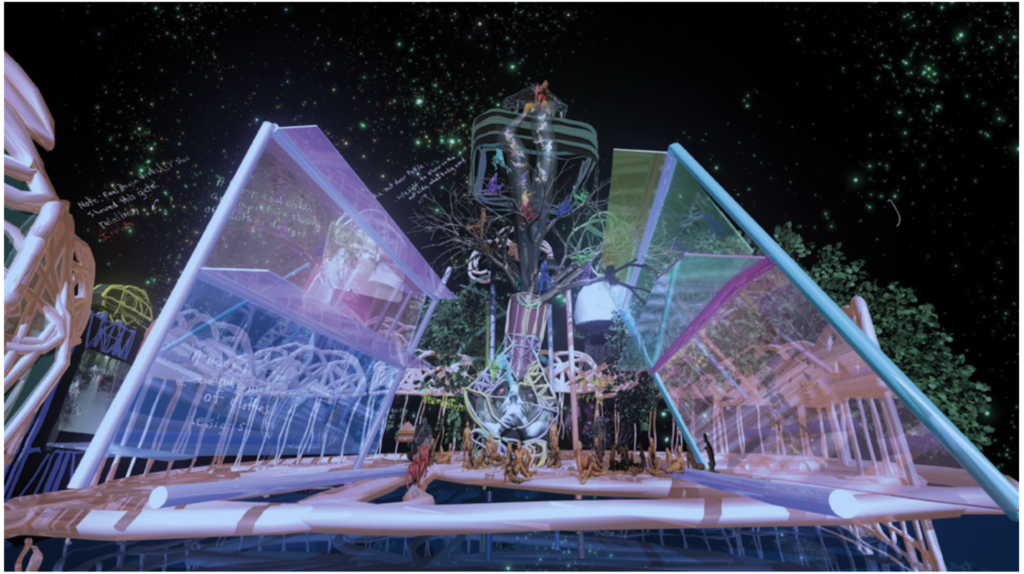
What the kids are watching VR works, in this instance at Moran Moran. I managed not to puke. Image courtesy of Kenny Schachter.
Lastly, the overall insurance valuation of €2.5 billion to €3 billion for the entire fair’s contents—about the same as last year—was tested when a Hauser & Wirth art handler knocked over a crate that set in motion a chain reaction of havoc not unlike the iconic (and comic) 1987 Fischli & Weiss video The Way Things Go. There was a domino effect of damage, but it could have been a lot worse, from what I’ve heard.
By the way, Gérard Faggionato has resigned from his employ at David Zwirner after a few years to return to private practice. Someone asked if that was publicly announced. I replied: “It is now.”
The End… for the Moment
I didn’t mean to give short shrift to the fair this year, all ye critics—it’s that everything else going on was at least as interesting. I’m neither admitting nor denying I wrote the following, which Richard Prince subsequently claimed authorship of on my Insta account:
“Larry Gagosian came up to me the other day & and told me one of his best friends had just died after a sudden illness. I said ‘What did he have?’ He said, ‘Oh, a nurse painting, a couple of Basquiat drawings & a pretty good Warhol.'”
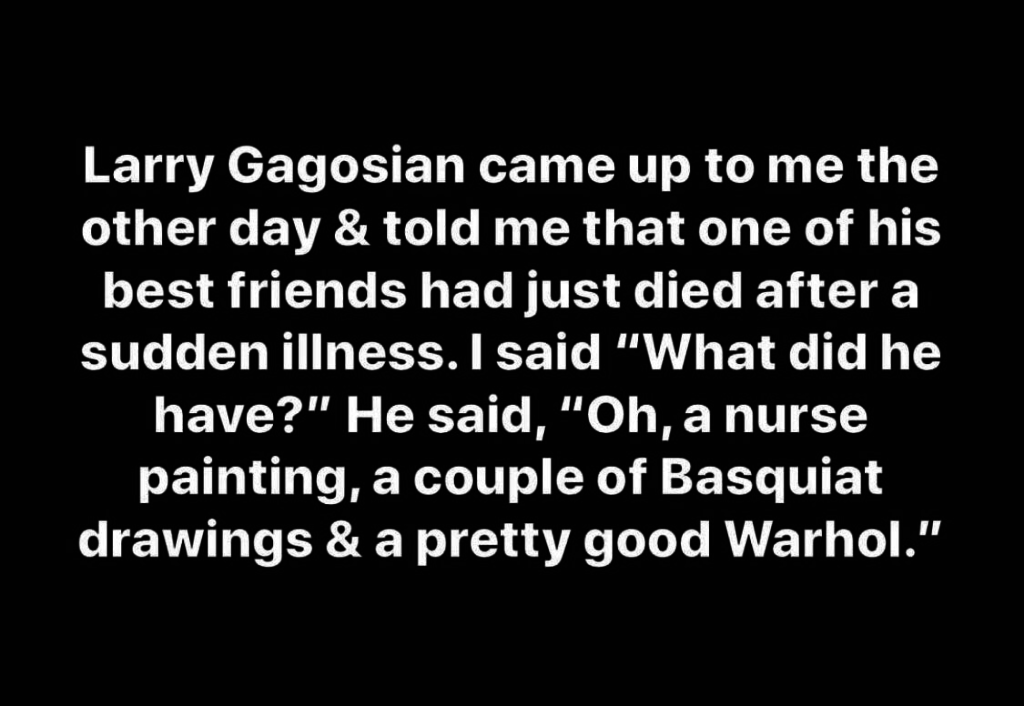
The joke is on the art world… actually it’s not—the art market is burgeoning. Artwork by Kenny Schachter.
That there are now art-world jokes circulating says it all. Until recently there was only one I was ever aware of, from years ago, involving Leo Castelli—which goes, to paraphrase: Leo rocks up to preferential treatment at the Pearly Gates, and other worthies left by the wayside are up in arms as to why. God replies, “We never had an art dealer before.” I’d add there will probably never be another. But that doesn’t make it any less of a load of fun.
